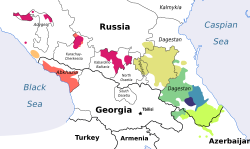|
Chirag language
Chirag (Chirag: хьаргънилла, xarʁnilla kub[2]) is a language in the Dargin dialect continuum spoken in Dagestan, Russia. It is spoken around the village of Chirag, but some speakers have moved to Kaspiysk. Chirag is often considered a divergent dialect of Dargwa,[3] despite not being mutually intelligible with literary Dargwa.[4] Ethnologue lists it under the dialects of Dargwa but recognizes that it may be a separate language.[5] ClassificationBased on lexical similarity, Chirag is usually classified as a separate language from other varieties of Dargwa.[6] It has 67% lexical similarity with the North-Central group, 77.6% with the South group, and 69% with Kaitag; within the South group, it has 84% lexical similarity with Qunqi Amuq.[6] It was apparently the first language to diverge from Proto-Dargwa.[4] Phonology
VowelsChirag has four vowels: /i/, /e/, /u/, and /a/,[7] along with two "epiglottalized" vowels, /iˁ/ and /aˁ/. Vowel length also exists for most vowels.[4] ProsodyIn Chirag, stressed syllables are specified for tone.[8] MorphophonologyChirag has some phonological processes that pertain to specific morphological elements. The plural suffix -e attracts stress and induces vowel deletion on the final syllable of disyllabic nouns (e.g., qisqan 'spider', qisqne 'spiders').[9] Verbal prefixes have optional front/back vowel harmony.[9] PhonotacticsThe permitted syllable structures are CV, CVC, and CVRT.[4] Grammar
Chirag is head-final, has fairly flexible word order and is rich with inflectional morphology.[10] It has ergative–absolutive alignment in its case marking; the subject of a transitive verb is overtly marked with ergative case, and the subject of an intransitive verb and the object of a transitive verb are unmarked:[1][10] (1) ʡale Ali(ABS) šːa home.LOC w-ačʼ-ib. M.SG-come:PFV-AOR.3 Ali came home. (2) ʡali-le Ali-ERG qa̰r-be apple-PL(ABS) d-iʡ-un. N.PL-steal:PFV-AOR.3 Ali stole apples. There are three noun classes, being male, female, and neuter. In the plutal form, however, the male and female classes are identical, thus leading to a two-way human-nonhuman opposition.[11] LexiconDue to the proximity of Chirag to Aghul, Lak, and Lezgin, it has some loanwords from these languages, such as марххале ("snow", derived from Lak марххале). UsageThere are efforts to enable automated translation of text from English to Chirag.[12] References
External links
|
||||||||||||||||||||||||||||


